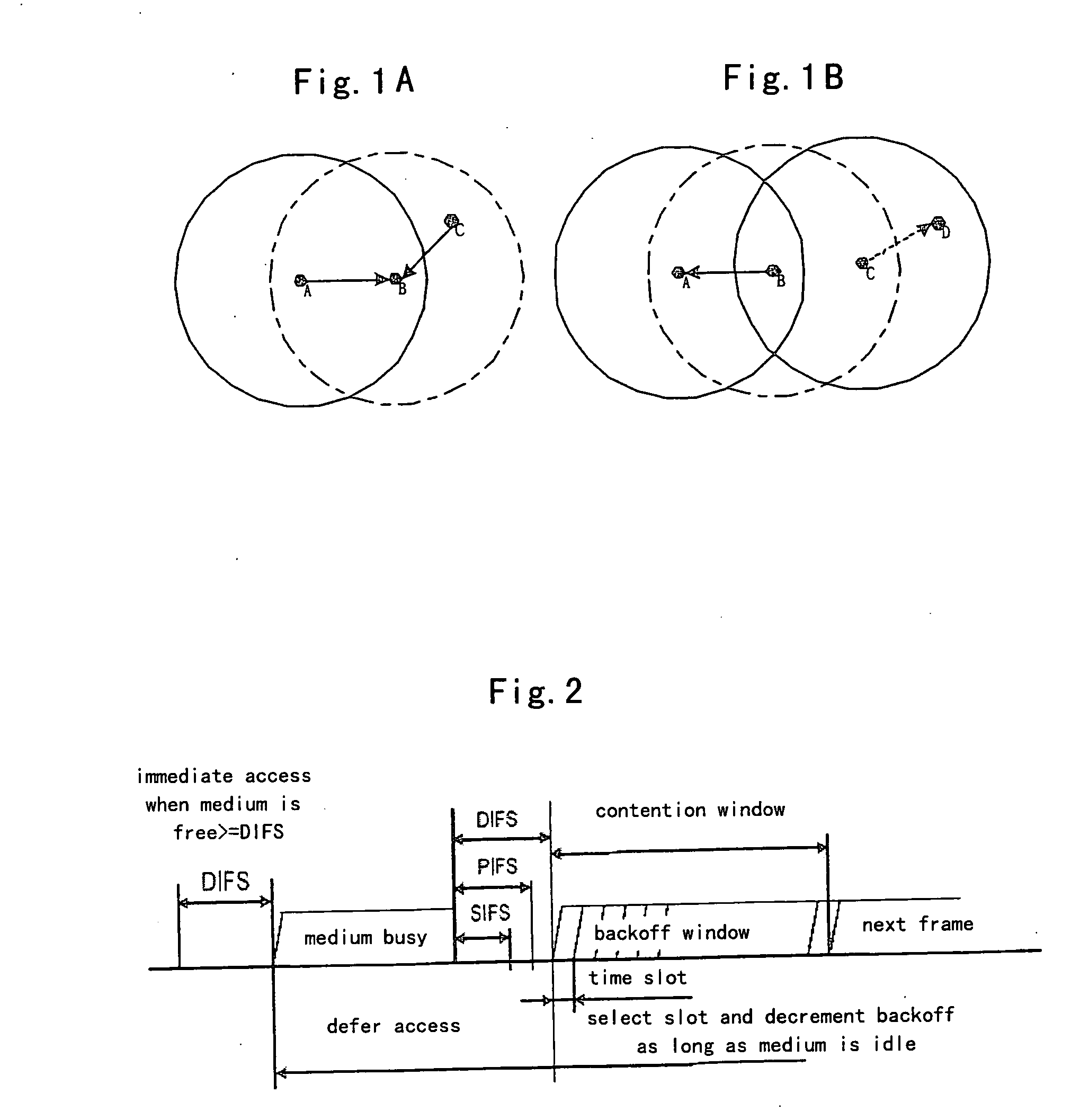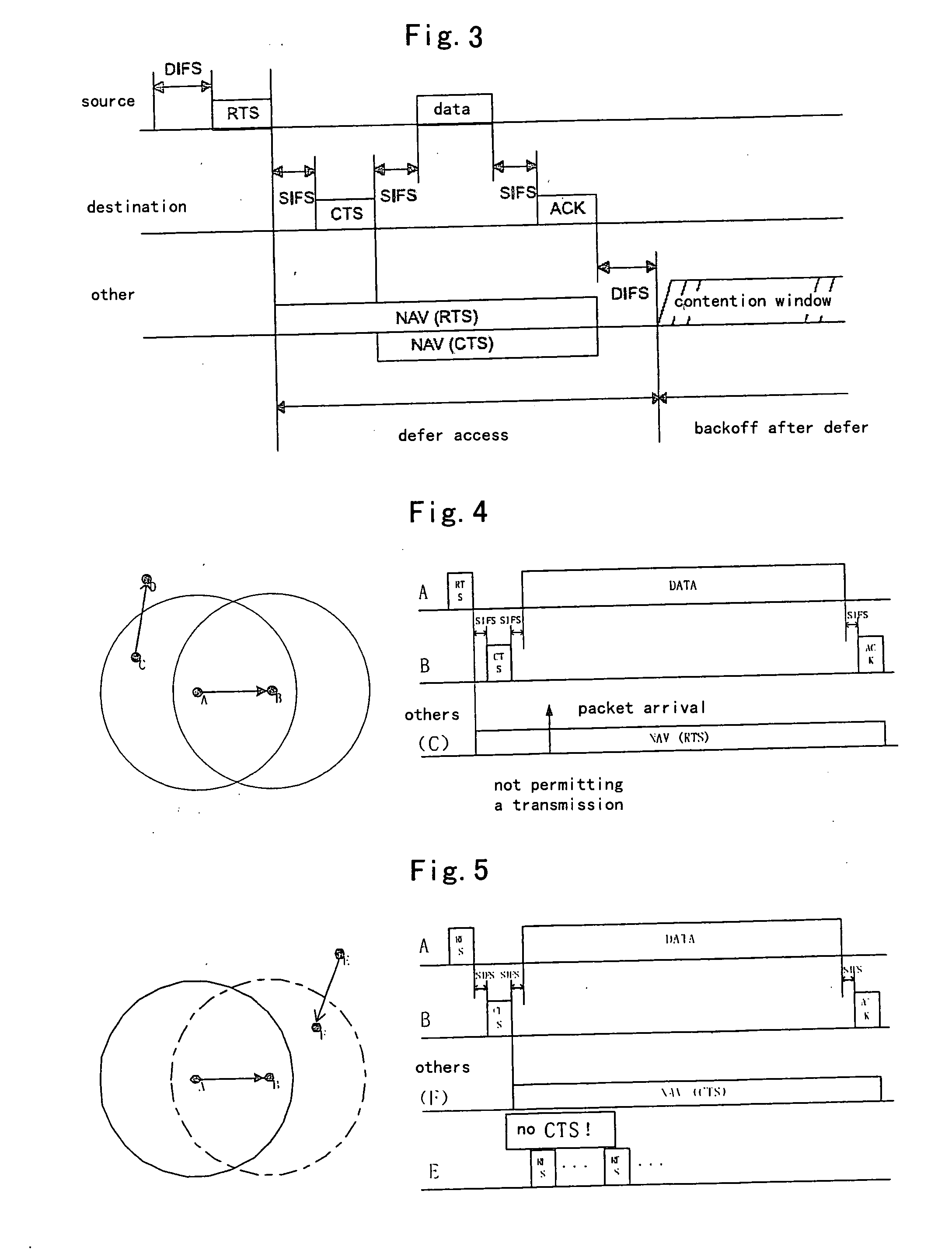Distributed wireless access method based on network allocation vector table and apparatus of the same
a wireless access and network allocation technology, applied in the field of distributed wireless access methods and apparatuses, can solve the problems of system resource waste, system performance degradation, exposed terminals, etc., and achieve the effect of improving system throughput and resource utilization rate, and reducing packet collision and resource was
- Summary
- Abstract
- Description
- Claims
- Application Information
AI Technical Summary
Benefits of technology
Problems solved by technology
Method used
Image
Examples
first embodiment
The First Embodiment
[0103]FIG. 13 is a diagram illustrating node distribution in the distributed wireless network according to the first, the second and the third embodiments of the present invention. In the FIG. 13, node A and node B are within the communication range of each other; node C is within the communication range of node A but not within the communication range of node B; and node D is not within the communication range of any nodes. Node A is to transmit a packet to node B; and node C is to transmit a packet to node D. The NAVT table is empty when a packet arrives in node A, and the NAVT table in node B is also empty.
[0104]FIG. 14 is a diagram illustrating timing sequence of the access method based on the NAVT without RTS / CTS exchange when node distribution is as shown in FIG. 13 in the case of no channel splitting.
[0105] At time to, a packet arrives at the transmitting storage unit 601 in node A. Node A detects that the packet arrives and the current NAVT is empty by ...
second embodiment
The Second Embodiment
[0115]FIG. 15 is a diagram illustrating timing sequence of the access method based on the NAVT with RTS / CTS exchange when the node distribution is as shown in FIG. 13 in the case of no channel splitting.
[0116] In the present embodiment, the operations concerning nodes A and B are the same as those in the first embodiment, the description of which is omitted herein.
[0117] At time t5, a packet arrives in node C. At this time, node C detects the arrival of packet by using the detecting unit 602, and further detects that only RTS item is indicated in its NAVT. The NAVT of node C at time t5 is shown in the third line on the right side of FIG. 15, wherein TAB—RTS—t5 indicates the value at time t5 under the control of the NAVT storage timer unit 607. Node C enters the channel sensing unit 604 via the determination unit 603, performs a data length fitting upon sensing that the channel is busy, and transmits the RTS2 packet by using the transmitting unit 606 based on t...
third embodiment
The Third Embodiment
[0123]FIG. 16 is a diagram illustrating timing sequence of the access method based on the NAVT with RTS / CTS exchange when node distribution is as shown in FIG. 13 in the case of channel splitting.
[0124] At time t0, a packet arrives at the transmitting storage unit 601 in node A. Node A detects that the packet arrives and the current NAVT is empty by using the detecting unit 602, and sends the determination result from the determination unit 603 into the channel selecting unit 707 to select the SCH. The SCH channel is sensed by the channel sensing unit 704. When it is sensed that the SCH channel is idle in the DIFS interval, the SCH channel is maintained by the channel selecting unit 708, and the RTS packet is started to send on the SCH by the transmitting unit 706 at time t1. The description of the partial fields in the RTS packet transmitted by node A is shown in the first line on the right side of FIG. 16, wherein the value of the duration field is TAB—RTS, in...
PUM
 Login to View More
Login to View More Abstract
Description
Claims
Application Information
 Login to View More
Login to View More - R&D
- Intellectual Property
- Life Sciences
- Materials
- Tech Scout
- Unparalleled Data Quality
- Higher Quality Content
- 60% Fewer Hallucinations
Browse by: Latest US Patents, China's latest patents, Technical Efficacy Thesaurus, Application Domain, Technology Topic, Popular Technical Reports.
© 2025 PatSnap. All rights reserved.Legal|Privacy policy|Modern Slavery Act Transparency Statement|Sitemap|About US| Contact US: help@patsnap.com



